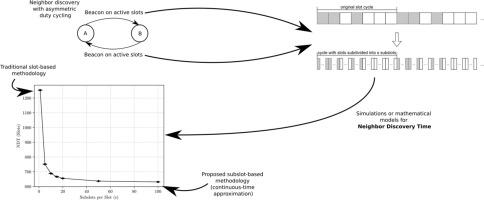A new methodology for evaluating the neighbor discovery time in schedule-based asynchronous duty-cycling wireless sensor networks
IF 1.6
Q2 MULTIDISCIPLINARY SCIENCES
引用次数: 0
Abstract
Duty cycling is a fundamental mechanism for battery-operated wireless networks, such as wireless sensor networks. Due to its importance, it is an integral part of several Medium Access Protocols and related wireless technologies. In Schedule-based Asynchronous Duty Cycle, nodes activate and deactivate their radio interfaces according to a pre-designed schedule of slots, which guarantees overlapping uptime between two neighbors, independent of the offset between their internal clocks, making communication between them possible. This paper presents a new methodology for evaluating the Neighbor Discovery Time (NDT) of Schedule-based Asynchronous Duty Cycle. Differently from previous methodologies, it accounts for the possibility of the slots in the schedules of the two neighbors not being perfectly border-aligned — an unrealistic assumption in practice. By means of simulation, we show that not taking this under consideration can lead to an overestimate of the NDT by a factor of 2 depending on the particular scenario, thus justifying the importance of our work.
- •We propose a new subslot-based methodology for computing the NDT of a wakeup schedule used for asynchronous duty cycling.
- •It replaces the traditional slot-based methodology, by dividing slots into subslots, allowing for the analysis of non-integer clock offsets between nodes, and further allowing mathematical models to consider the more realistic continuous-time case.
- •Our validation data shows that the slot-based methodology may overestimate NDT by a factor of up to 2, making the proposed subslot-based methodology much more precise.

评估基于计划的异步占空比无线传感器网络中邻居发现时间的新方法
占空比是电池供电的无线网络(如无线传感器网络)的基本机制。由于其重要性,它已成为若干介质访问协议和相关无线技术的组成部分。在基于时间表的异步占空比中,节点根据预先设计的时隙时间表激活和停用其无线电接口,从而保证两个相邻节点之间的正常运行时间重叠,不受其内部时钟偏移的影响,使它们之间的通信成为可能。本文提出了一种评估基于时间表的异步占空比的邻居发现时间(NDT)的新方法。与以往的方法不同,它考虑到了两个邻居时间表中的时隙不完全边界对齐的可能性--这在实践中是不现实的假设。通过仿真,我们证明了不考虑这种情况会导致 NDT 被高估 2 倍,具体取决于特定场景,从而证明了我们工作的重要性。-它取代了传统的基于插槽的方法,将插槽划分为子插槽,允许分析节点之间的非整数时钟偏移,并进一步允许数学模型考虑更现实的连续时间情况。
本文章由计算机程序翻译,如有差异,请以英文原文为准。
求助全文
约1分钟内获得全文
求助全文
来源期刊

MethodsX
Health Professions-Medical Laboratory Technology
CiteScore
3.60
自引率
5.30%
发文量
314
审稿时长
7 weeks
期刊介绍:
 求助内容:
求助内容: 应助结果提醒方式:
应助结果提醒方式:


